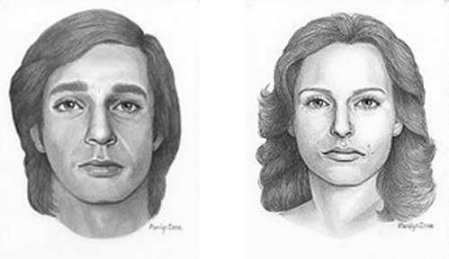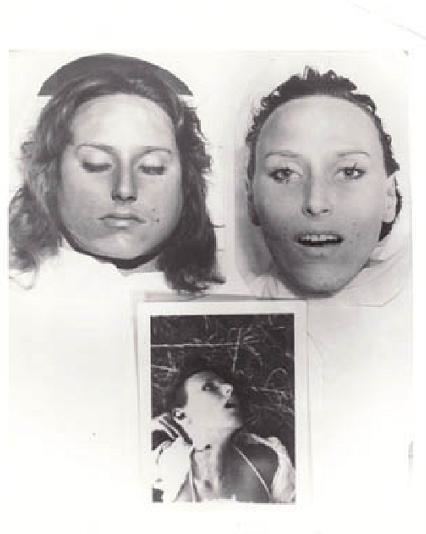Height 6 ft 1.25 in (1.86 m) | Name Sumter Does | |
 | ||
Status Unidentified for 39 years, 5 months and 23 days Weight 150 lb (68 kg) (approximate) | ||
Cause of death Homicide by firearm Similar Murder of Paul Broussard, Murder of Scott Amedure, Tommy Burks | ||
Sumter County Does | Jock and Jane Doe
The Sumter County Does, also known as Jock Doe and Jane Doe, were two unidentified homicide victims found in Sumter County, South Carolina, on August 9, 1976. They had apparently traveled through various places in the United States before being killed in South Carolina. This was inferred from some of their belongings.
Contents
- Sumter County Does Jock and Jane Doe
- Discovery of the bodies
- Male victim
- Female victim
- Leads and theories
- Burial
- References

Each victim had been shot three times, receiving one shot in the throat, one in the chest, and one in the back. The weapon used was believed to be a .357 caliber revolver.

Sumter County Coroner Verna Moore continued to work on the case until her retirement in 2009. The case remains unsolved. Neither of the victims' identities has been found, despite the fact that their descriptions, sketches of their faces, dental information, and fingerprints were distributed across the United States.

Authorities decided to halt the investigation until the victims' identities could be discovered.

The male victim's nickname "Jock" may have originated from the French name "Jacques." A man who claimed he had met the victims stated that he was told by the male victim that he had left his Canadian family with his girlfriend. The man said that the male victim stated that his father was a well known doctor; this supported the theory that his family was wealthy.

Discovery of the bodies
In the early morning hours of August 9, 1976, the young man and woman were said to have been seen from a distance by a hermit. It was said they had been dropped off on Locklair Road, a secluded dirt road between I-95 and S.C. 341 (Lynches River Road).
It is possible that the victims had their vehicle hijacked, possibly by hitchhikers. Then, upon their exiting the vehicle, someone shot them both in the back.
At 6:20 a.m., a man named Martin Durant found the bodies and contacted Charles Graham, an employee at a nearby store. Graham, in turn, contacted the authorities.
Male victim
The male victim was at first believed to between 18 and 22 years of age, but his dentition suggested that he may have been older than 27. The age range was updated to be between 18 and 30 years after his case was entered into NamUs.
The forensic dentist who examined the man's teeth said he believed he was over 27, but that he had looked younger due to his clothing and build. The victim was white with an olive complexion. He had brown, shoulder-length hair, brown eyes, and very distinctive bushy eyebrows. He stood over 6 feet tall, weighed about 150 pounds, and had had extensive, elaborate, dental work that may have been performed outside the United States. This might indicate a higher socioeconomic status.
A unique type of root canal surgery had been perfomed during the man's life, which could be important for discovering who he was. It looked as if he had been midway through a complete dental restoration. The man had a four-inch appendectomy scar. He also had various scars on his back and shoulders, which indicated frequent participation in contact sports.
He was wearing faded Levi brand jeans and a red T-shirt. The shirt read "Coors — America's Light Beer" on the front and "Camel Challenger GT Sebring '75" on the back, along with a Snoopy design. The shirt was apparently a promotional item from the Sebring Races held in Sebring, Florida, in 1975, which were sponsored by the Coors Brewing Company. He wore no underwear and carried a pack of "Grant's truck stop" matches in a pants pocket. The matches are believed to have come from a Grant's Truck Stop in the Midwest.
He wore a yellow gold Bulova Accutron wristwatch with a Twist-o-Flex band, bearing the serial number H918803. Using this number, investigators were able to determine that Bulova had made the watch in 1968. But when the Bulova company downsized in the early seventies, they destroyed many of their records, meaning that there was no way to ascertain where the victim's watch was distributed or bought. He also wore a 14-karat gold ring set with a gray star sapphire stone. The initials JPF were engraved inside the ring, which had a Florentine finish. Both the ring and the watch were rather expensive. This, together with the man's elaborate dental work, suggested that he had come from an affluent family.
Female victim
The female victim was slightly younger than the man. She was originally thought to be between 18 and 20 years old. After her case was entered into NamUs, her age estimate was increased to 18 to 25 years. She stood 5' 5" tall, weighed 100 to 105 pounds, and had a slim build and an olive complexion like that of her companion. This led some observers to speculate that they may have been siblings.
She had reddish-brown, shoulder-length hair and bluish-gray eyes (some sources state "hazel"). She had two distinctive moles on the left side of her face near her mouth.
The coroner noted that the young woman had unusually long, natural eyelashes and that both victims were very clean and well-groomed. She had fillings in all of her back teeth, and her front teeth would have appeared straight and even if she were to smile. She had no surgical scars, had never been pregnant, and her legs had not been shaved. Unlike her male companion, no scars were found on her body.
She was wearing an unbleached white muslin blouse over a pink, front-tying halter top. She wore blue denim cut-off shorts (Daisy Dukes). She had a floral print scarf tied around her waist as a belt.
She wore Stride-Rite brand wedge-heeled sandals that were lavender and hot pink in color.
She wore three very distinctive rings.
These rings appeared to be authentic handmade Native American or Mexican costume jewelry. They were all made of sterling silver. They appeared to have originated in the Southwestern United States.
Like the man beside her, the female victim wore no underwear.
Leads and theories
In 1977, a man was arrested in Latta, South Carolina, for driving while intoxicated. He owned a revolver (found in his vehicle) of the same kind as the murder weapon. It was proved to actually be the murder weapon after it was test-fired by investigators. The man was located but was not charged because there was insufficient evidence against him.
Investigators traveled to the city of Brunswick, Georgia. They met with a mother and father who were thought to be possible acquaintances of Jane Doe. A missing woman's ex-boyfriend had reported a similarity between the female victim and his ex-girlfriend. After showing the parents of the missing woman photographs of the female victim, neither they nor friends of the missing woman could verify that she was the female victim. After a dental comparison, it was found that the two women did not match.
The initials JPF engraved inside the man's ring supported the theory that his name was Jacques.
The book of matches found in the man's pocket provided some clues. The matches came from a truck stop chain which had locations in Idaho, Nebraska, and Arizona. After information was released to the public, a man from Nebraska stated that he may have performed repairs on a car with Oregon or Washington license plates, whose owners matched the description of the victims. But this uncovered no additional leads.
Some speculate that Henry Lee Lucas, a serial killer, could be involved in the Sumter County Does' murders. Lucas himself told police that he had been in South Carolina the day that the victims died, but was never charged. He died in 2001 due to heart failure. Lucas had confessed to two murders that also happened in Sumter County, that of an elderly woman in 1975 and of a young man in 1983. Like most other leads, this revealed no additional clues to the pair's names or their actual murderer.
In 2007, both bodies were exhumed to obtain DNA information. The theory that the pair were siblings was then disproved. The testing showed that they were not genetically related, though they resembled each other.
Burial
The couple's bodies were kept at a local funeral home in caskets with airtight, see-through lids in hopes that someone would identify them. People from all over the country called to inquire about them, including several distraught parents of young runaways. None was able to identify the bodies.
The bodies remained on display until they began to deteriorate. On August 14, 1977, one year and five days after the bodies were found, they were interred in Bethel United Methodist Church Cemetery in Oswego, South Carolina. Hundreds attended the funeral service. The law enforcement agency raised several hundred dollars to pay the funeral home.
Their graves have bronze markers which read, "Male Unknown" and "Female Unknown."
